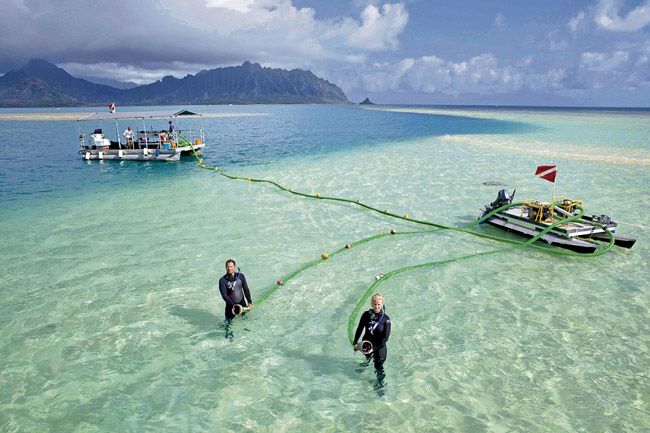Second Super Sucker Joins Algae Cleanup In Kaneohe Bay

The addition of this second Super Sucker (at right), unveiled Sept. 27 by The Nature Conservancy in Kaneohe Bay, will work in tandem with the original one now operated by the state, more than doubling the amount of invasive algae that can be removed from the bay. TNC also has launched a $2.5 million fundraising campaign to remove the algae from the north end of the bay by 2015. Photo from Grady Timmons of TNC.
A new barge-mounted vacuum cleaner, Super Sucker 2, is in Kaneohe Bay, launched this fall to nibble away at the stubborn, invasive algae that’s settled on the reef.
The Nature Conservancy and the state Division of Aquatic Resources (DAR) are partners in the latest effort to break up the chokehold the algae has on parts of the bay. The goal is to clear the bay’s north end of the worst algae by 2015 – a doable task, according to the group’s executive director Suzanne Case, if they can raise $650,000 more to reach the $2.6 million needed to pay for it. That’s the price tag for keeping up the pace of removing 5,000 pounds of algae a day for three more years. (To support the effort, supporters are welcome to send checks to The Nature Conservancy, Kaneohe Bay Project, 923 Nuuanu Ave., Honolulu HI 96817.)
The process uses employs Super Sucker 1 (now operated by DAR), the Conservancy’s Super Sucker 2, two barges and two divers for each machine. They feed algae into hoses that connect to pumps that bring it onto barges. The Hawaii Institute of Marine Biology on Coconut Island helped launch Sucker 1 and now provides a base for both barges.
Each Super Sucker also is supported by a Mini Sucker, which enables it to reach shallow patch and fringing reefs throughout the bay.
“By having two Super Suckers – and plenty of urchins,” said Ed Conklin, the Conservancy’s director of marine science, “we will finally be able to remove algae faster than it can grow and spread. That will make a big difference for the bay.”
The state, meanwhile, is growing native sea urchins at its hatchery on Sand Island and placing them on the reefs, where they keep the algae in check. Divers and fishermen should be aware of their presence and leave the hungry urchins to their mission.





